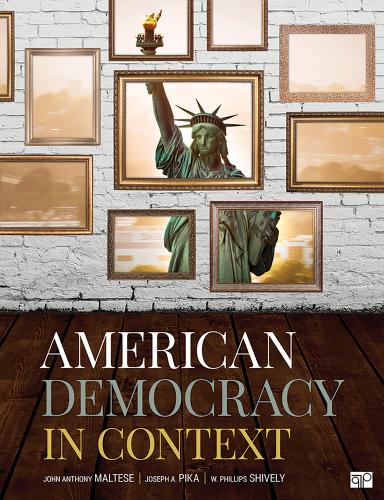6 Part II Civil Liberties and Civil RightsChapter 4: Civil LibertiesPerspective: How Much Government Control of the Internet is Too Much—or Too Little?The Bill of RightsThe Bill of Rights and the States: The Original UnderstandingThe Incorporation of the Bill of RightsThe First Amendment Freedoms of Speech, Press, and AssemblyFreedom of the Press and Prior RestraintWhat Did the Framers Mean by “Freedom of Speech”?The Alien and Sedition Acts of 1798The Supreme Court Confronts Restrictions on SpeechSymbolic SpeechObscenityLibel and SlanderFalse AdvertisingCampus SpeechFreedom of AssemblyThe First Amendment Guarantee of Freedom of ReligionThe Establishment ClauseThe Free Exercise ClauseThe Right of PrivacyThe Natural Rights TraditionDiscovering the Right of PrivacyAbortionExtending the Liberty of Same-Sex CouplesThe Right to DieThe Rights of Criminal DefendantsDue Process Rights of the AccusedPicture Yourself … As A Prospective Juror In JapanJudicial Expansion of the Rights of the Criminally AccusedThe Death PenaltyBalancing National Security With Civil LibertiesConsequences for DemocracyChapter 5: Civil RightsPerspective: The Confederate Monument DebateSlavery in AmericaSlavery and the ConstitutionSlavery and the Supreme CourtCivil Rights for African Americans After the Civil WarThe Black Codes and the Civil Rights Acts of the 1860s and 1870sThe Supreme Court Intervenes: The Civil Rights Cases and Plessy v. FergusonThe Rise of Jim Crow Laws and Barriers to VotingAfrican American Civil Rights in the Twentieth CenturyThe NAACP and the Fight for Civil Rights Through the CourtsBrown v. Board of EducationThe Civil Rights MovementCongress Takes ActionBlack Lives Matter and White NationalismWomen and Equal RightsThe Fight for Women’s SuffrageWomen’s Rights in the Wake of the Nineteenth AmendmentThe Equal Rights AmendmentSexual Harassment in the WorkplacePicture Yourself … As a Woman In ZambiaEqual Pay for Equal WorkTitle IXDiscrimination Based on EthnicityNative AmericansImmigrantsThe Current Controversy Over ImmigrationHispanicsNew Frontiers in Civil RightsLGBT RightsDisability RightsRedressing Past DiscriminationAffirmative ActionApologies and ReparationsConsequences for Democracy
7 Part III People and PoliticsChapter 6: Public Opinion and Political SocializationPerspective: What Difference Does Public Opinion Make?Public Opinion and Political CulturePolitical ToleranceTrust in GovernmentPolitical EfficacyPolitical Knowledge and Attention to IssuesPicture Yourself … As a Young Person in ChinaPolitical SocializationFamiliesPeer GroupsSchoolsCollegeMediaWorld and Political EventsAmerican ExceptionalismGroup Differences in the United StatesAgeRace and EthnicityReligionSocial ClassGenderHow Public Opinion ChangesGenerational ReplacementChanges in Party IdentificationHow Ideologies Gain Their StructureHow Public Opinion Is MeasuredPolling TechniquesCluster SamplingRandom Digit DialingInternet PollingPolls in Political CampaignsTracking PollsExit PollsPush PollsLimitations of PollsConsequences for DemocracyChapter 7: Political Parties and Interest GroupsPerspective: How Centralized can Political Parties be?Defining Political Parties and Interest GroupsPurposes of a Political PartyCampaigningMobilizationRecruitment and Socialization of LeadersProviding IdentityProviding a Channel for ControlThe Development of American Political PartiesEarly Party FormationThe First Party System, 1800–1820The Second Party System, 1828–1854150 Years of Democrats and RepublicansThe Golden Age of Parties, 1860–1900Republican Dominance and Progressive Reform, 1900–1932The New Deal and Democratic Dominance, 1932–1964Republican Recovery, 1964–PresentReforms Weaken the Parties: Round TwoThe Parties TodayElectoral Realignments and Partisan ChangeThe Structure of American PartiesThe Party in the ElectorateThe Party OrganizationState and Local Party OrganizationsNational CommitteesCongressional Campaign CommitteesThe Resurgence of National Party OrganizationsThe Party in GovernmentParties in CongressPresidents and PartiesParties in State GovernmentThe Two-Party SystemThe U.S. Electoral System and the Two-Party SystemThird Parties in the Two-Party SystemThird Parties Can Make a DifferenceResponsible Party GovernmentPicture Yourself … As A Member Of Great Britain’s Conservative PartyInterest Groups in American PoliticsCitizen GroupsCorporationsLabor UnionsTrade, Professional, and Agricultural AssociationsOther Groups That Lobby OfficialsSocial MovementsMovements That Have Made a Major ImpactInterest Group Representation and the Organization of Public OpinionOrganization of the Well-OffProducer Interests and Consumer InterestsSpecial Circumstances Affecting Group OrganizationContiguous ResidenceAgeStrategic LocationConsequences for DemocracyChapter 8: Nominations and ElectionsPerspective: How Long Should Election Campaigns Last?The Development of Elections in the United StatesThe Presidential CampaignSelecting the DelegatesPrimaries and CaucusesHow Representative Are Primaries and Caucuses?The Road to NominationThe Early Contests: The Importance of TimingFrontloading and the Schedule of ContestsThe National ConventionCandidate Selection Compared With Other CountriesPicture Yourself … As An Engaged VoterThe General ElectionCongressional ElectionsManipulation of District BoundariesIncumbents’ Other AdvantagesControl of the NewsStaff to Support ConstituentsEasier Access to Campaign ContributionsExperienceParty AccountabilityElectoral Systems and Their EffectsThe United States: Winner-Take-AllProportional RepresentationThe Electoral College and Presidential ElectionsPopular Versus Electoral VotesStrategic CampaigningAnti-Participation EffectsSmall-Population Versus Large-Population StatesCasting Pledged VotesPositive EffectsProposals for Changing the Electoral CollegeElections and the Representation of Women and MinoritiesCampaign FinanceThe Dilemma of Limiting Campaign SpendingRegulating Campaign Finance for Parties and CandidatesCompliance and DisclosureLimits to ContributionsPublic Financing for Presidential
